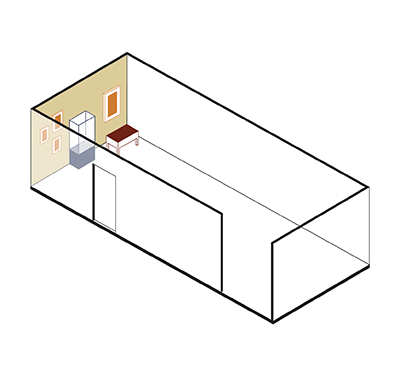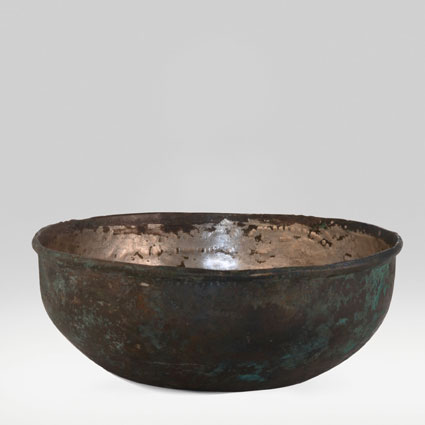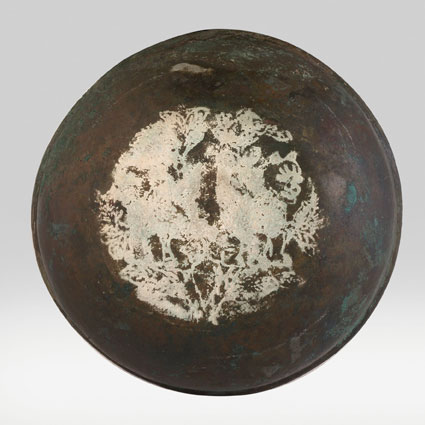
ABR 040
Code: ABR 040
Country: Tibet
Style: Imperial Period
Date: 700 - 800
Dimensions in cm WxHxD: 11 x 5.7 x 11
Materials: Silver
The outer face of the bowl is covered by a dark patina partially green surface.
Only the inner side of the bowl has been cleaned.
The bottom of this circular bowl is decorated at the inside with linear engravings of a pair of winged lions in front of a tree. In addition, the rim of the bowl is decorated on the outside with dotted marks forming a floral register. This object was allegedly discovered in the greater Dulan area (Qinghai province). The workmanship and the design are of a different type than Chinese silver works of art dating from the Six Dynasties, Sui Dynasty, or the Tang Dynasty. Althought the winged types of lions known as Senmurv or also Simurgh, originate in Iran, they are of a different type than the lion decorating this silver bowl. Instead of resembling Chinese or Persian lion sculptures, they rather show similarities with early Tibetan stone carvings of lions. These form part of the small corpus of Tibetan stone sculptures carved in the round and dating from the first propagation of Buddhism during the Tibetan Imperial Period (c.600-842). The most famous of these is the pair of stone lions on the burial mound of Khri srong Ide brtsan (reigned c. 756-797) in the 'Phyong rgyas valley, located in Central Tibet. 1 Another stone lion was excavated at the Dulan burial grounds, presumably dating from the 8th/9th c.2 There is a strong possibility, that this silver bowl is the workmanship of a Tibetan artist.
(Formerly von Schroeder Coll.)
Carter, Martha L. , 1979. "An Indo-Iranian Silver Rhython in the Cleveland Museum". Artibus Asiae, Vol. XLI, 4. Artibus Asiae. Pp. 309-25, 9 pls - References to early silver works
Carter, Martha L. , 1998. "Three Silver Vessels from Tibet's Earliest Historical Era: A preliminary study", Cleveland studies in the History of Art, Vol. 3. Cleveland: Studies in the History of Art. Pp. 22-47, illus - References to early silver works
Czuma, Stanislaw J. , 1992. "Some Tibetan and Tibetan-Related Acquisitions of the Cleveland Museum of Art", Oriental Art, New Series, Vol. XXXVIII (1992-92) No. 4. Oriental Art, New Series. Pp. 231-243, illus - References to early silver works
Heller, Amy, 2003. "Archaeological Artefacts from the Tibetan Empire in Central Asia", Orientations, Vol. 34, No. 4, (April 2003). Orientations, Vol. 28, N°10. Pp. 55-64, 16 figs - References to early silver works
Lo Bue, Erberto F, 1981. "Statuary metals in Tibet and the Himalayas: history, tradition and modern use", Aspects of Tibetan Metallurgy, edited by W.A. Oddy and W. Zwalf. London: British Museum Publication. References to early silver works
Rawson, Jessica, 1982. The Ornament on Chinese Silver of the Tang Dynasty (AD 618-906), British Museum of art", Oriental Art, New Series, Vol. XXXVIII (1992-93) No.4. London: British Museum Publications. Pp. 231-243, illus - References to early silver works
Riboud, K., 1983. "Brief Comments on the Depiction of the Simurgh (Winged Lion)". National Museum Bulletin, Nos. 4-6. National Museum Bulletin. Pp.107-17, figs. 92-110 - References to winged lions
Uldry, Pierre, 1994. Chinesisches Gold und Silber: Die sammlung Pierre Uldry, (Austellungskatalog Museum Rietberg, Zurich, 1994). Zurich: Austellungskatalog Museum Rietberg. References to early silver works
Watts, James C.Y. and Wardwell, Anne C. , 1997. When Silk Was Gold: Central Asian and Chinese Textiles, (catalogue of the exhibition held at the Cleaveland Museum of Art, October 26, 1997-January 4, 1998). New York: The Metropolitan Museum of Art. Pp. 68, 80-81, 142,-143, fig. 22, nos. 19, 35: Textiles, Central Asia, circa 13th c. - References to winged lions



